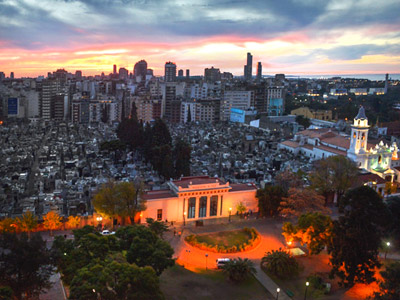BUENOS AIRES
BUENOS AIRES
Buenos Aires is often referred to as the "Paris of South America", but it is much more than that. The city has characteristics of major global cities such as Paris, Vienna, Rome, Barcelona, Havana, San Juan, Miami, and others. But Buenos Aires is isolated, a sprawling metropolis of over 12 million people, located well below the equator (closer to Antarctica, in fact) in the quadrant of the Far East of Argentina. Anyone who has seen the theatrical or cinematic version of "Evita" has witnessed the colorful history of the city. Buenos Aires (which, more or less translated, means "fresh air") was originally founded in 1536, but the Spanish sent to colonize the mouth of the Rio de la Plata were forced to leave the indigenous population. A second, more successful attempt was made in 1580, and it was only at the beginning of the 1800s that the city and then the country freed themselves from the Spanish crown, becoming the Argentine Republic. One might think that the planning by the French, the buildings by the Spanish, and the statues by the Italians would have lent a schizophrenic air to this sprawling capital. But the fact that the population is a melting pot of European and South American cultures (half of the citizens of Buenos Aires are of Italian origin) makes the city more open and cosmopolitan, celebrates differences, and welcomes tourists from around the world. But don't be fooled by appearances - Buenos Aires may look and feel like a European city, but scratch the surface and soon you'll realize that Buenos Aires is a South American city with real South American challenges. The main ones are massive unemployment and a huge influx of migrant workers from neighboring countries, most of whom live in slums on either side of the main highways in the area called Villa 31. Although not as famous as Rio's favelas, these slums lack running water, electricity, basic sanitation, and schooling and the authorities are trying to figure out how to incorporate them into the city. The country also fights with high inflation and unemployment. More than elsewhere in the country, Buenos Aires has felt the effects of years of over 2,000 percent of inflation, and this is still felt today. When the Argentine economy collapsed in 2001, the "Portenos" - as the residents of the city call themselves, referring to the origins of the city as a port - took to the streets asking someone to be held responsible. Others formed collectives to buy and manage their jobs. The other side of the coin, of course, was that the devaluation of the Argentinean peso made the visit to the city very convenient, and tourism prospered. Even today, most of the city's goods and services remain a huge bargain for visitors from Europe or North America. (The subway runs a total of 30 cents and a main course for the steak costs about $15.) Hoteliers have become wise to this attraction and housing prices have risen. However, the opening of more properties, particularly of the boutique variety, and the rise of Airbnb means that there is much competition and you can find good prices. Compared to stays in other world-class cities, a trip to Buenos Aires is a real bargain and once you've visited, you'll probably want to come back. The city offers numerous designs: architecture, hectares and hectares of woods and parks, fabulous dishes of traditional grilled meats, and abundant Argentine wines. Visitors also appreciate the sparkling Latin, the soul of the portenos, and the genuine warmth and humor of the people. Bask in the camaraderie of a bar (even if you don't speak Spanish), the thrill of watching a couple perform a tango in a corner of San Telmo, the smile of a child wearing a Boca Juniors T-shirt. Perhaps you will have the privilege of receiving a sip of yerba from the cup of a stranger (pronounced mah-day), a social tradition in Argentina. Perhaps a shopkeeper will point you in the direction of a fabulous tavern. And maybe you'll dance the tango in an after-hours social club.
